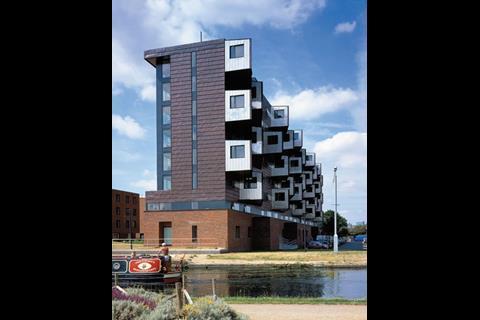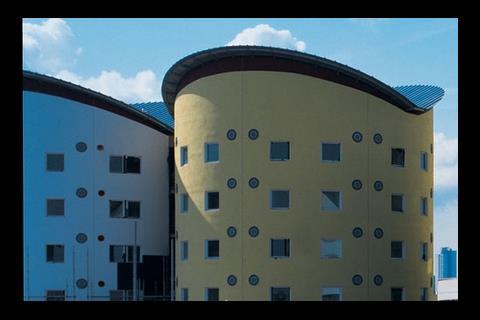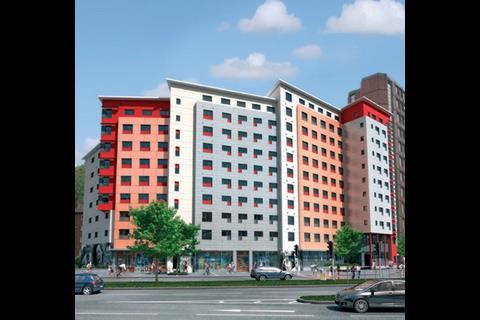The academic year has started and a fresh intake of students is moving into brand new housing. Simon Rawlinson of Davis Langdon explores this dynamic and price-conscious market
01 — Introduction
The market for student accommodation is buoyant. The introduction of student fees and the phasing out of g33rant support for most students has done little to dampen demand for college places. Universities now compete openly for students and funds, and this has placed a greater emphasis on the quality of a college’s academic and pastoral care.
Student numbers are growing at about 3% a year and there are now more than 1.5 million students in full-time education in the UK. Colleges that lack quality accommodation risk deterring potential students. In the current property market, it has also become a relatively safe and high-performing investment.
Traditionally, most students have relied on the private sector for accommodation – currently, 45% are housed in the independent sector. However, greater demand for places, increased regulation, rising house prices and growing concern about the impact of student lifestyles on local communities have led to a contraction in supply from small-scale landlords.
In their place have emerged specialist developer-operators such as Unite, and diversifying housing associations. They provide study bedrooms in large-scale developments, either on behalf of specific universities or directly marketed to students. The private sector has provided 100,000 bed spaces over the past five years and is expected to become the largest provider of residential space to the higher education sector by 2010. There is clearly scope for further growth.
Aspirations to compete in the conference market – and to a lesser extent, the budget travel business – have driven up the quality of college-provided accommodation for a number of years. The entry of the private sector into the student housing market has raised the bar yet further and some universities are taking their older properties off the market as they no longer meet quality expectations.
At the premium end of the market, Blackstone’s Nido development in King’s Cross, north London will be charging £180/week rent for a single self-contained pod.
The drive for quality is, however, not without its critics. While many loan-funded students will be enjoying hotel-style comforts in their en-suite study bedrooms, other students will struggle to pay the rent. The National Union of Student has pointed out that there continues to be a role for simple, low-cost accommodation to ensure the widest possible access to the benefits of higher education. Refurbished buildings can help to meet this requirement.
Student accommodation has a vital role to play for universities, students and even the students’ parents, many of whom will be picking up the tab:
• Universities need to maintain their competitive recruitment position. Housing is typically close to the top of a students’ list of priorities and the ability to guarantee a space in a good-quality, well-located residence is a big recruitment differentiator. The university also has an overriding concern that the accommodation provided is competitive in the local marketplace, that it supports the development of the students in their care and, where the buildings are their responsibility, that the fabric is robust and cost effective to run and maintain.
• Students need help to make the transition to independent living as well as adapting to university life. Student housing will provide the backdrop and pastoral support to the majority of students in their first year and to an increasing number throughout their full stay at university.
• Parents want to ensure their children are safe and well catered for and that they are getting value for money.
• Investors see the student residence market as offering a reliable long-term income stream, with short lettings that provide regular opportunities to adjust to price levels and lease terms. Student accommodation is also emerging as an asset class in its own right – rental income across the whole sector is about £4bn a year and the capital value of student accommodation is thought to total £17bn.
Students don’t live in isolation and the emergence of “studentification” as an economic trend in many cities has led to concerns over the impact on local communities of this typically transient population.
Universities bring prestige and their students’ considerable spending power to communities, but they bring disruption too – particularly for small university towns such as Loughborough, where 22% of the term-time population are students.
Large-scale accommodation provision takes some of this pressure off local neighbourhoods, although it also takes the rent and other expenditure out of the local economy and directs it towards larger service providers.
02 — Getting student housing right
Student accommodation should be a fairly simple building type: there is plenty of repetition, little requirement for complex building services and less need for long-term flexibility than in an office building. Treated in this way, quite a lot of highly functional and banal accommodation has been built in the past few years, often making little connection with its surroundings and failing to resolve the challenge of design with repetitive elements.
The best projects, however, demonstrate that quality can be achieved within the constraints of tight budgets and immoveable deadlines. Some of the issues that need to be considered in tailoring a development to its market and location include:
• Target market. A recurrent theme in the provision of student accommodation is that quality standards are driven by other markets, such as the need to provide en-suite facilities for conference guests or to compete with budget hotels.
Operators in the private and public sectors are certainly focused on exploiting the full value of their estate, though the conference business is driven by a university’s need for prestige as well as by income.
Other aspects of market focus include overseas students. Universities with a strong international presence are investing heavily in accommodation with these well-funded students in mind. They provide, for example, larger study bedrooms than might be specified for a typical student development.
Other examples of target markets include “self-selected” groups of students, who choose to live together in their second and third year, and postgraduates, who may be permanent residents and for whom research-led universities are competing in an international marketplace. For groups, the key is providing self-contained accommodation, featuring relatively small numbers of study rooms arranged around common access stairs and shared facilities.
• Repetition. Developer-operators such as Unite can achieve considerable economies of scale though the use of standard room types. Unite has its own modular solution, whereas other providers use various modern methods of construction such as flat-pack or tunnel form to deliver good quality at high volumes.
Study bedrooms are the most intensively used part of a development and are the focus of most expenditure. Due to repetition, they also offer the greatest opportunities for value engineering. However, savings in these areas, typically on furniture, lighting and so on, can have an impact on long-term durability and performance. As space allowances on most developments are pretty tight, a typical en-suite bedroom is no larger than 12-13m2 and expenditure on the proprietary en-suite WC/shower will have already have been rationalised, there are relatively few opportunities to take out further cost without affecting the quality and durability of the building. Other areas where difficult trade-offs may need to be made include:
- The extent of circulation space. In student housing, circulation is social space and the drive to keep down overall areas per room may result in schemes that are less welcoming
- The arrangement of circulation space. Either corridors or rooms of staircases will also have an impact on the quality of community and the degree of security felt by students.
• Communal facilities. Self-catering is the most popular option. In recent years, the trend has been to reduce the number of study bedrooms per kitchen to increase ownership of communal space. The factors that dictate planning include means-of-escape distances and the physical constraint of module dimensions on the size of shared facilities. Provision of site-wide communal facilities such as common rooms, bars, laundries and gyms is an important part of the mix, particularly for schemes developed away from town centres or the university campus.
• Personalisation. The experience of university estates teams is that rooms and facilities are better looked after if there is plenty of opportunity for occupants to personalise their spaces. Large pin boards and generous storage facilities in a room help to provide this personal touch.
• Build quality. Durability is a key issue for all operators, particularly for windows, finishes and furniture, fixtures and equipment. The shift towards en-suite rooms has addressed many of the maintenance problems that used to be associated with heavily used communal bathing facilities, although water damage is a recurrent problem.
Key issues in current developments relate to providing good-quality robust furniture in bedrooms and kitchens, detailing finishes to avoid risks of impact damage and specifying appropriate carpets and so on. Unfortunately, the furniture budget regularly comes under cost pressure on these projects.
• Building service installations are relatively simple. The main issues to be addressed in design and specification include:
- Economic provision of capacity, particularly hot water to deal with peak demand in the morning
- Low-cost operation: simple room controls for lighting and so on help cut energy use
- Individual control: background heating is often provided using underfloor systems for simplicity and robustness. Options for individual control of temperature often rely on provision of supplementary electrical panels. Issues with cost and Part L compliance have made it increasingly difficult to incorporate this provision in the base-build, increasing the likelihood that students will use their own potentially inefficient heaters instead.
• Ease of maintenance. Like hotels, student accommodation needs to be designed to facilitate maintenance with minimal disruption to residents. Services to individual study bedrooms should all be capable of isolation and other elements that require regular cleaning and maintenance, such as windows, must be specified to make this easier.
• Premium services. Accommodation providers, particularly those in the private sector, are engaged in a fierce struggle to get “first mover” advantage and a national brand.
This is increasingly achieved by a combination of a basic all-in package – including card-access security, broadband, TV and internal phones – with premium services such as external phone lines, cleaning and laundry provided at an extra cost.
The advantage of the all-in package is that, while possibly more expensive, it helps students with the management of their budgets through the avoidance of unexpected extras. At the top end of the market, Blackstone’s Nido has its own screening room for films, sports events and performances.
03 — Cost drivers
Cost drivers for student accommodation include:
- Study bedrooms. Only 30% to 40% of the cost of a study bedroom varies according to area. As a result, there is little opportunity for value engineering other than by changing levels of quality or functionality. Any changes to bedrooms will have a significant cost and time impact on the project, particularly if made at a late stage.
- Substructure and roofing costs. Most schemes are arranged over four storeys in response to means-of-escape and other fire regulations. Substructures and roof costs can have a disproportionate impact if site abnormals require non-standard solutions.
- External walls. As study bedrooms are small, overall building widths are narrow and wall to floor ratios are relatively high. This increases the sensitivity of overall building costs to the quality and cost of the facade.
- Space allowances and efficiency. Typically, areas per room range from 22 to 25m2. Design of student accommodation should not be driven by the need to minimise the area per room. However, the proportion of study bedroom space to gross can be around the 50% to 60% mark. The extent of circulation may be a significant driver of overall floor areas.
- Vertical circulation strategy. The selection of an access strategy based either on multiple cores, or cores and corridors, will affect the extent of stairs, external doors and so on.
- Expenditure on furniture, fixtures and equipment.
04 — Procurement and construction
There are distinctive sub-markets within the student accommodation sector, particularly between private sector and university providers. That said, risk management is a key consideration for most of these providers, particularly with regard to certainty of delivery and control of change.
Another common trend is the opportunities that repetition can provide to support varying levels of modern methods of construction (MMC). Some university clients are able to commission one-off schemes following traditional sequential procurement routes. These clients, typically Oxbridge colleges, have provided a small but distinctive design-led workstream for a number of years.
Most university clients, however, are faced with the pressures of keeping borrowing associated with student accommodation off their balance sheets and ensuring delivery by the beginning of an academic year, together with considerations of long-term management. They have tended to adopt some form of partnership approach to the delivery of their accommodation, either through a lease agreement with a developer or through the adoption of nomination or reservation agreements with an independent service provider.
The net effect of most of these requirements is that, while the university client may have stringent requirements with regard to design quality, sustainability and ongoing performance, the contractual mechanism to deliver the buildings is typically highly commercial and risk averse. In most cases, clients use design and build, often with some initial consultant design input.
The most significant risk in the delivery of student accommodation relates to programme and the need for all schemes to be completed ahead of an academic year. Unite, for example, has completed 10 schemes in London this year and it is heavily dependent on the performance of its in-house and external supply chains to achieve this. Unite’s year-round production of bedroom pods is managed to supply sufficient units ahead of the critical on-site phase, which will coincide on so many of its projects.
Adoption of MMC clearly helps with regard to the simplification of on-site works and testing, but can potentially introduce significant sources of problems associated with the delivery of key components such as pods, precast units and so on.
Alternative approaches to managing this risk of supply-chain failure include:
- Using on-site MMC techniques, such as tunnel-form construction
- Partnering the supply chain
- Securing forward delivery of key components such as pods
- Taking the module manufacture process in house, in order to guarantee both supply and on-time delivery.
Other project management issues that concern all developers in the university and private sector include effective change control and the ability to value-engineer the project to ensure delivery, when necessary, within tight financial constraints.
05 — Sustainability and student housing
Universities are taking a leading role in specifying sustainable buildings. This is partly from a fitness-for-purpose perspective, but also because the university estate can be used to teach sustainability principles covered in college courses.
Running costs have long been a concern for university estates departments and there is an track record of energy-efficient student housing characterised by a focus on insulation, air-tightness of the external envelope and effective control of building services in bedrooms.
The student accommodation built over the past 10 years on the University of East Anglia campus in Norwich is a good example. As clients demand higher targets – many aspire to a BREEAM excellent rating a wider range of sustainability components are coming under consideration. These focus primarily on reducing carbon emissions, managing water and specifying materials with a low environmental impact.
As intensively occupied buildings, student residences should provide plenty of opportunity for performance improvement. However, as the population is relatively transient, systems must be easy to understand and acceptable to a diverse population.
06 — Cost model breakdown
The breakdown features a large four-storey block providing 310 study bedrooms arranged in groups of 10 around communal space.
The development is based on a tunnel-form solution with blockwork masonry walls. The external facade features a combination of cavity wall and an insulated render rainscreen. The scheme forms part of a larger development project on campus.
The table includes furniture, fixtures and equipment in study bedrooms and common areas. There are no facilities such as bars in this scheme. The costs of site preparation, external works and services, loose furniture, operating supplies, professional fees and VAT are excluded.
The rates set out in the cost breakdown are derived from a competitively tendered project let on the basis of two-stage design and build. Preliminaries reflect the programme benefits of modern methods of construction and the design-and-build route.
Rates are current in the fourth quarter of 2007, based on a location in the South-east.
Rates should be adjusted for site conditions, programme, procurement route and location.
Downloads
a - Cost breakdown & b - Location factors
Other, Size 0 kb




























No comments yet